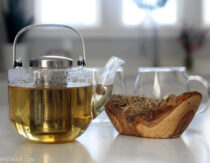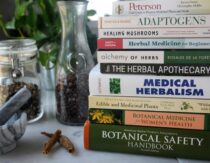
Need a hug in a mug? That’s how Katja Swift and Ryn Midura, co-authors of Herbal Medicine for Beginners, describe linden tea. Made from the leaves and flowers of the fragrant linden tree, linden tea and tincture have a long history of use for releasing nervous tension, easing various types of discomfort, supporting the heart (both the muscle and our emotional state), and more.
Linden isn’t overly picky about its environment, so it grows in many places and is widely esteemed for its beauty, therapeutic properties, and fragrant blossoms . . . in fact, the flowers are used to make perfume! Considered safe for people of all ages, it’s easy to prepare for use both internally and topically. (1) There are some contraindications, though, so be sure to read the safety section below.
Before we dive into specifics, I want to remind you that that none of these statements have been evaluated by the FDA, this article is not medical advice, and it’s not meant to diagnose or treat any condition. If you have a question about whether any herb or dietary supplement is right for you, please talk with a qualified healthcare professional. Okay, let’s dive in!
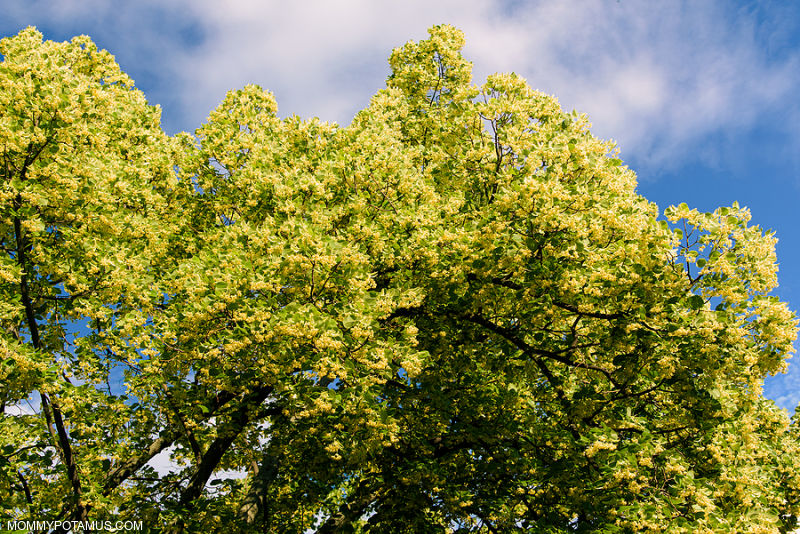
What is linden?
Because it is “at home in almost any temperate climate, enjoying the balmy Mediterranean basin as much as frigid Vermont,” linden can be found in many places throughout Europe, Asia, and North America. (2)
Also called lime blossom, basswood, lime tree, linden (Tilia spp.) it’s made up of about 30 species.
Some trees have a low, compact form; others, such as the American basswood (T. americana), grow tall and lanky with arching canopies. All species share a similar inflorescence [aka flower cluster], which isn’t showy and opens quietly around midsummer. Though your eyes may not see it, your nose cannot miss it – a relaxing, almost intoxicating smell, echoed in the extract’s floral, honey-like flavor.” (3)
The main parts that are used therapeutically are the flowers, bract, and leaves, but the bark is used occasionally to support liver detoxification or as a gentle laxative. (4)
If you’re wondering what a bract it, it’s a small leaf-like structure that’s found just below the flower. Linden bracts are rich in soothing polysaccharides, and the flower/leaf/bract combined also contain essential oils, “flavonoids (kaempherol, hespiridin, quercetin, astralagin, tiliroside, others); miscellaneous: mucilage (in the bract), phenolic acids, tannins” (5)
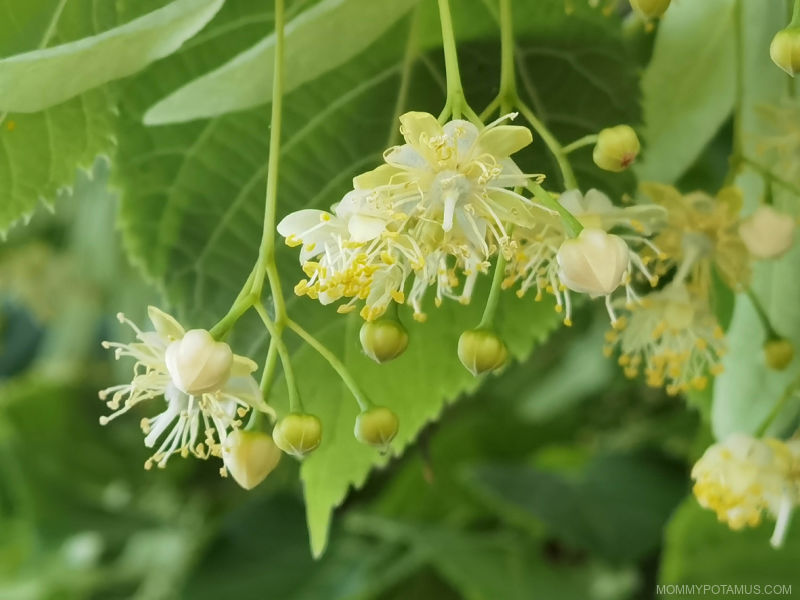
Linden trees bloom in mid to late summer, and the flavor of the flowers is “velvety, floral, slightly bittersweet” and honey-like. (3) We’re not the only ones who appreciate them, either. A single tree can produce up to 40 pounds of nectar in a season, making linden a favorite with honeybees. (6)
Linden is available as a varietal honey, which basically means it’s unique because honeybees mostly make it from the nectar from a single variety of flower (aka the varietal). In southern France’s fields of Provence, bees make a famously delicious lavender honey, and in New Zealand Australia they make honey from manuka flowers. Honey made from linden blossoms is highly aromatic and has a strong flavor that is described as slightly minty and woody.
Linden’s therapeutic properties, including the ability to help calm the heart and mind, have made it a beloved part of many communities.
For example, in Slovenia and the Czech Republic, “majestic old lindens served as gathering points for the local community, and villages would hold court under their branches, confident that the tree would ensure justice but also bring about peace and an amicable resolution to conflict. In many villages, this practice continues today.” (2)
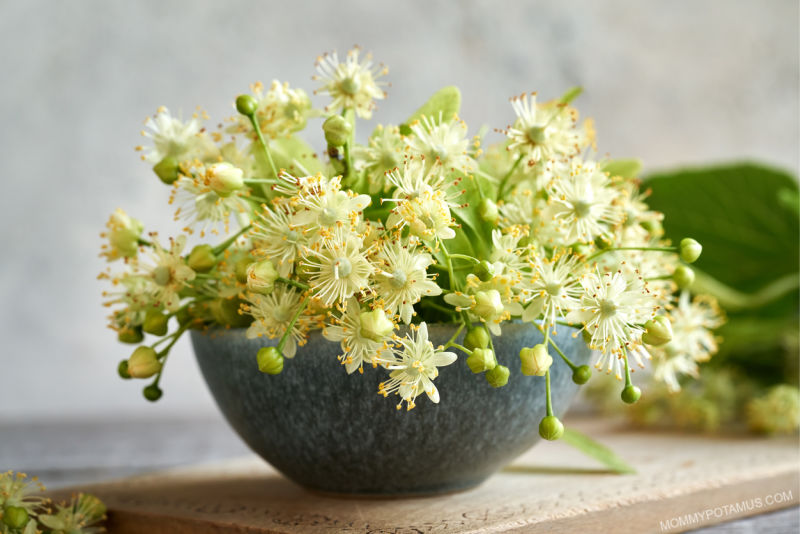
8 Benefits of Linden
Linden has a long history of use for a variety of concerns including feelings of anxiousness, stress, digestive discomfort, cold and flu support, and more. Here’s an overview of its benefits.
1. Relaxation for the Stressed, Anxious & Overwhelmed
We call linden ‘a hug in a mug.” When what you really need more than anything is a hug and someone to tell you that everything is going to work out all right, linden can give it to you! Sure, it’s just a cup of tea, but linden’s relaxing and soothing powers can really change your whole outlook on life – and sometimes that’s exactly what we need.” – Katja Swift and Ryn Midura, Herbal Medicine for Beginners
Linden is what herbalists call a “relaxing nervine”, which means that it calms overstimulation and creates a sense of peace by nourishing the central nervous system.
According to JJ Pursell, author of The Herbal Apothecary:
Linden is a universally safe nervine relaxant for people of all ages. Children who tend to be hyperactive physically or emotionally, from overstimulation, fear, or fatigue, will benefit from the use of linden, as will adults who are overworked or under high amounts of stress. Linden helps them regain emotional control and breath. If tension or pain is involved, linden opens up and relaxes tension pathways.”
In one study done with a species of linden called Tilia tomentosa, an extract of flower buds mimicked the activity of gamma-aminobutyric acid. (7) Also known as GABA, gamma-aminobutyric acid is one of our main sedative neurotransmitters.
To use linden for relaxation, Wild Medicine Solution author Guido Masé recommends that we:
Try it at the end of the day to unwind. It slightly shifts consciousness into a more joyous and calm place, allowing us to relax and appreciate life for a moment. You can also drink it throughout the day, especially if work or family are sources of stress that foster anxiety and frazzled thinking.” (2)
2. Restorative Sleep
In folk medicine, linden is often given to support deep, restorative sleep . . . the kind that leaves you feeling positive and rested the next morning. (4) Though more research is needed, its sleep supporting properties may be due to its influence on GABA receptors
3. Cold & Flu Support
Linden is considered a diaphoretic, which means it supports the fever process. According to Texas Children’s Hospital, ”Fevers are a protective mechanism and a sign that the body’s immune system is turned on. Most fevers are good for sick children and help the body fight infection.” (8)
According to Richo Chech, author of Making Plant Medicine, “Sipping hot linden tea produces a marked vasodilating effect, bringing increased blood supply to the capillary bed.” Drawing the blood supply toward the capillary bed of our skin promotes sweating, which helps cool the body.
“The most obvious response to fever is that vasodilation (an attempt to cool down the body) increases blood flow, thus increasing the sheer number” of lymphocytes (white blood cells) that are delivered to where they’re needed. (9) (10)
In Germany, 1-2 cups of hot linden tea is approved as a “sweat infusion” for kids 12 and over when taken at bedtime. (11)
4. Digestive Support
“Herbalists prescribe a simple tea for many types of belly issues, from heartburn to gas and bloating (though its effects on problem like constipation is less pronounced). The aromatic quality is relaxing to the muscle lining in the gut, and the smooth, soothing nature of the tea softens and heals areas of irritation.” (2)
5. Soothes Sunburns, Sprains & More
Linden tea can be applied topically to soothe burns and sunburns. To use it, brew a strong cup of tea and allow it to cool. Dip a soft washcloth or cotton ball into the tea, wring excess liquid if needed, and apply it to the area.
Fresh linden can also be used as a poultice for sprains and similar concerns. You’ll find instructions for making a poultice below.
6. Eases Muscle Tension & Nerve Discomfort
According to Richo Chech, author of Making Plant Medicine, “Anyone with a propensity to uncontrolled spasm of leg muscles, which make even the most stolid warrior cry out ‘Uncle,’ are well-advised to take a little linden tea, which tends to banish the charley horse to the barn.” (4)
It’s also traditionally used to soothe menstrual cramps and nerve discomfort. (1)
7. Antioxidant Support
We know that excessive amounts of free radicals – which our bodies produce as byproducts of metabolism – cause oxidative stress that can lead to accelerated aging and several disease processes throughout the body. Fortunately, as this Live Science article puts it,
Antioxidants are able to give an electron to a free radical without becoming destabilized themselves, thus stopping the free radical chain reaction. ‘Antioxidants are natural substances whose job is to clean up free radicals. Just like fiber cleans up waste products in the intestines, antioxidants clean up the free radical waste in the cells,’ said Wright.”
Linden contains a variety of antioxidants that help counteract free radicals. Specifically, extracts made from the flower, leaf and bract are rich in:
- Tiliroside, a flavonoid that helps relax blood vessel walls and soothe inflammation. (12)
- Kaemphferol, a flavonoid that supports autophaghy (cellular cleanup mode). (13) (14) (15)
- Quercetin, a flavonoid that supports the strength and integrity of capillaries. Antioxidants including quercetin also support cardiovascular health by protecting lipids from oxidation. (16)
- Tannins, which are the beneficial compounds also found in red wine, green tea, etc.
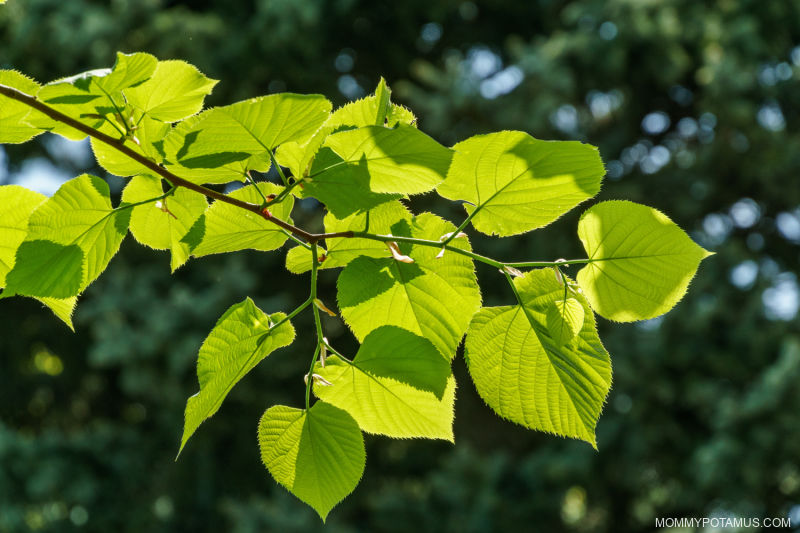
8. Cardiovascular Support
For the heart, tilia is a great ally – so it’s nice to note that its leaves are generally heart-shaped, though this varies a little depending on species (there are over thirty of them.” (2)
Linden contains several compounds – tiliroside and quercetin, for example – that help relax the inner muscles of blood vessels, causing them to widen. (12) (17) This vasorelaxation effect increases blood flow and eases tension within blood vessel walls.
Quercetin also supports the strength and integrity of capillaries. (17)
Antioxidants including quercetin also support cardiovascular health by protecting lipids from oxidation. (16)
In Europe it is routinely recommended as a “safe adjunct to conventional therapy” for people with certain cardiovascular issues. (2)
With that said, there is conflicting guidance regarding the safety of linden for people with cardiovascular issues. Many of the texts I rely on for safety information, including Medical Herbalism and The Botanical Safety Handbook, do not list any known safety concerns for linden when its used appropriately.
However, several sources state that heart damage has been recorded in rare instances after “excessive and prolonged usage in susceptible individuals.” (18) When I tried to locate the original study or case report to learn more I was unable to find it. Neither could EBSCO Complementary and Alternative Medicine Publishing, which states that “this appears to have been a case of authors quoting one another for decades in succession; the original source of this concern is unclear.” (19)
Until more information is available, I recommend following Making Plant Medicine author Richo Cech’s guidance, which is that “People suffering from heart problems or hypotension should not take this herb.”
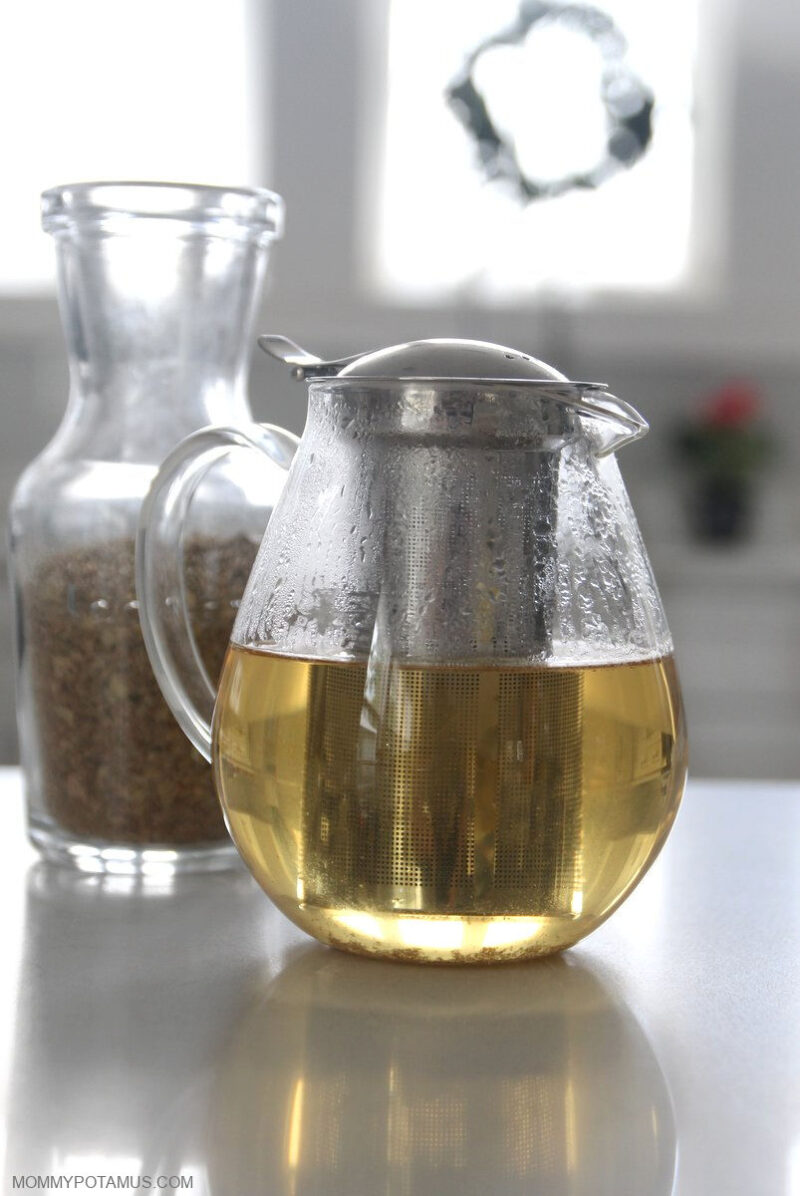
Linden Tea Recipe
“The linden can steep for three or thirty minutes, for it will have none of the astringent unpleasantness of an overbrewed green or black tea. On the contrary: the infusion is round, velvety almost, slightly thickened by simple starches found in the bract. Coupled with its distinctive fragrance, it truly is a luxurious experience for such a simple ritual and is perhaps my favorite kind of tea.” Guido Mase, The Wild Medicine Solution
A printable version of this recipe can be found at the bottom of this article.
Ingredients:
- 1-3 teaspoons dried linden flower and leaf (1-2 teaspoons for relaxation, 2-3 for diaphoretic support)
- 1 cup boiling water
Directions:
- Pour boiling water over the linden, cover the cup with a plate, and let it steep for 10 minutes.
- Strain out the linden and sweeten your herbal tea with honey, maple syrup, or any other sweetener if desired.
Note: “A cup of linden tea is soothing in the moment, but for chronic or long-standing issues, plan to make linden a supportive part of your daily life.” (1) Most sources suggest between 1-3 cups per day. (5) (20)

How To Make Linden Tincture
Early June can, indeed, be bottled and relived during dark winter months.” – Jovial King and Guido Masé, DIY Bitters
A printable version of this recipe can be found at the bottom of this article.
Tinctures are one of the easiest ways to incorporate herbs into a full schedule. I like to add mine to tea or water to help me relax and unwind. The general tincture formula recommended for linden is a 1:5 ratio (1 ounce herb by weight, 5 ounces alcohol by volume) in 40% alcohol. (Medical Herbalism)
However, because linden is very fluffy, I have found that I need to add a little extra alcohol to make sure it is fully submerged. Another option is to grind it a little before adding alcohol so that the herb is more compact.
Ingredients:
- 1 ounce dried linden flower and leaf (by weight)
- 5 ounces 80 proof alcohol (40% alcohol by volume)
Pour the alcohol over the herbs, then cover the jar with a lid and shake it well. If desired, write the start date on the jar using a sticky note, label, or piece of tape – it makes keeping track of how long it’s been steeping easier.
Place the jar in a dark, room temperature area. (I keep mine in a kitchen cabinet.) Let the mixture steep for 3-5 more weeks. Shake occasionally.
When the tincture is ready, use a mesh colander or cheesecloth to filter out the herbs. Pour the tincture in a clean jar or dropper bottle and store it in a cool, dark area.
To Use
Medical Herbalism suggests 2.5 to 5 ml (approximately 1/2-1 teaspoon) 3 times daily.
How To Make A Linden Poultice
“The fresh leaves of linden are loaded with healing mucilage and may be ground up or blended with a little water, applied in a thick layer to the affected area, and left on for half an hour or more.” (4) It can be used to soothe “wounds, sprains, and swellings. For easement of arthritic joints, briefly steam the leaves and apply hot, insulating with towels.” (4)
Safety Considerations
As I mentioned above, there is some conflicting information regarding lindens safety. According to the Botanical Safety Handbook, 2nd edition, it’s a Safety Class 1A herb – the safest rating possible. It is described as:
- Herbs that can be safely consumed when used appropriately.
- History of safe traditional use
- No case reports of significant adverse events with high probability of causality
- No significant adverse events in clinical trials
- No identified concerns for use during pregnancy or lactation
- No innately toxic constituents
- Toxicity associated with excessive use is not a basis for exclusion from this class
- Minor or self-limiting side effects are not bases for exclusion from this class”
Medical Herbalism concurs, saying that no side effects or drug interactions have been reported. However, several sources state that heart damage has been recorded in rare instances after “excessive and prolonged usage in susceptible individuals.” (18) When I tried to locate the original study or case report to learn more I was unable to find it. Neither could EBSCO Complementary and Alternative Medicine Publishing, which concluded that “this appears to have been a case of authors quoting one another for decades in succession; the original source of this concern is unclear.” (19)
Until more information is available, I recommend following Making Plant Medicine author Richo Cech’s guidance, which is that:
The prescribed dosage is generally safe for regular use by children and adults, even if pregnant or nursing. People suffering from heart problems or hypotension should not take this herb. The foliage of the tree may cause contact dermatitis among predisposed individuals. Breathing the pollen may result in an allergic response.” (4)
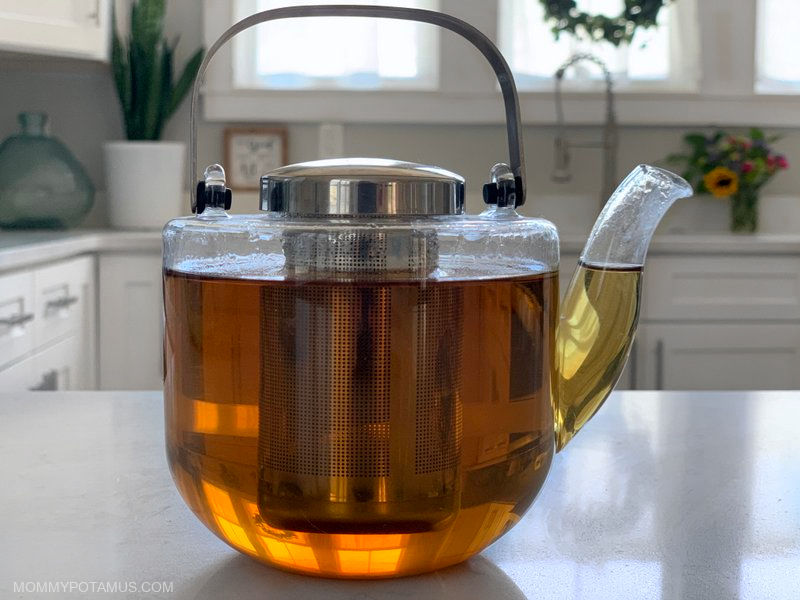
More Calming Herbs To Try
Lemon Balm – This flavorful herb is gentle yet potent, making it perfect for use with kids & adults for supporting relaxation, deep sleep, first aid, and more.
Passionflower – Passionflower has been used for centuries to support sleep, provide stress support, calm the mind, lift mood and more.
Catnip – You might be wondering why you should care about catnip. I mean, it’s for cats, right? Yes, but it’s also amazing for people who need to relax, or want to help their kids wind down for bed, or who need some digestive support. So basically everyone.
Linden Tea & Tincture Recipes
Ingredients
Tea Recipe
- 1-3 tsp dried linden flower and leaf (1-2 teaspoons for relaxation, 2-3 for diaphoretic support)
- 1 cup boiling water
Tincture Recipe
- 1 oz. dried linden flower and leaf (by weight)
- 5 oz. 80 proof alcohol (40% alcohol by volume)
Instructions
Tea Instructions
- Pour boiling water over the linden, cover the cup with a plate, and let it steep for 10 minutes.
- Strain out the linden and sweeten your herbal tea with honey, maple syrup, or any other sweetener if desired. Most sources suggest between 1-3 cups per day.
Tincture Intructions
- Pour the alcohol over the herbs, then cover the jar with a lid and shake it well. If desired, write the start date on the jar using a sticky note, label, or piece of tape – it makes keeping track of how long it’s been steeping easier.
- Place the jar in a dark, room temperature area. (I keep mine in a kitchen cabinet.) Let the mixture steep for 3-5 more weeks. Shake occasionally.
- When the tincture is ready, use a mesh colander or cheesecloth to filter out the herbs. Pour the tincture in a clean jar or dropper bottle and store it in a cool, dark area.
- To use, Medical Herbalism suggests 2.5 to 5 ml (approximately 1/2-1 teaspoon) 3 times daily.
Notes
Want more research-backed natural remedies?
No problem, I’ve created a free ebook for you – Kitchen Apothecary: 25+ Natural Remedies Using Ingredients From Your Pantry – as a gift for signing up for my newsletter. You’ll also get updates when I post about safe essential oils for pregnant/breastfeeding mamas, exclusive gifts and coupons (I was able to give away a jar of free coconut oil to anyone who wanted it recently!), plus other goodies.
Sign up using the form below.
Sources
- Katja Swift and Ryn Midura (2019) Herbal Medicine for Beginners
- Guido Masé (2013) The Wild Medicine Solution: Healing with Aromatic, Bitter, and Tonic Plants
- Jovial King and Guido Masé (2016) DIY Bitters: Reviving the Forgotten Flavor – A Guide to Making Your Own Bitters for Bartenders, Cocktail Enthusiasts, Herbalists, and More
- Richo Cech (2016) Making Plant Medicine
- David Hoffman (2003) Medical Herbalism
- Rock Bridge Trees (2017) The Mighty Linden Tree
- Arianna Allio et. al. (2015) Bud extracts from Tilia tomentosa Moench inhibit hippocampal neuronal firing through GABAA and benzodiazepine receptors activation
- Texas Children’s Hospital. Top 5 Fever Myths And Facts
- William A. Wells (2006) Fever brings in the lymphocytes
- Science Daily (2019) Fever alters immune cells so they can better reach infections
- European Medicines Agency (2012) Assessment report on Tilia cordata Miller, Tilia platyphyllos Scop., Tilia x vulgaris Heyne or their mixtures, flos
- Daniel M. Grochowski et. al. (2018) A Review on the Dietary Flavonoid Tiliroside
- Kim, Tae Woo et. al (2018) Kaempferol induces autophagic cell death via IRE1-JNK-CHOP pathway and inhibition of G9a in gastric cancer cells
- Gülnur Toker et. al. (2004) Flavonoids with antinociceptive and anti-inflammatory activities from the leaves of Tilia argentea (silver linden)
- Allen Y Chen and Yi Charlie Chen (2013) A review of the dietary flavonoid, kaempferol on human health and cancer chemoprevention
- Sahebkar, Amirhossein (2017) Effects of quercetin supplementation on lipid profile: A systematic review and meta-analysis of randomized controlled trials
- Serban, Maria‐Corina et. al. (2016) Effects of Quercetin on Blood Pressure: A Systematic Review and Meta‐Analysis of Randomized Controlled Trials
- The University of Texas at El Paso. Herbal Safety: Linden Tree
- BSCO Complementary and Alternative Medicine Review Board. Linden
- JJ Pursell (2015) The Herbal Apothecary: 100 Medicinal Herbs and How to Use Them


